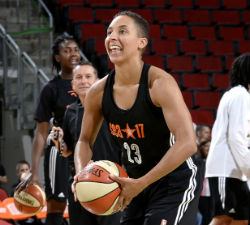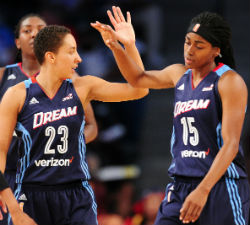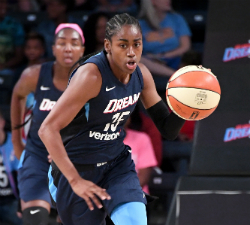Ever-Evolving Tiffany Hayes Making the Most of Increased Opportunities

NEW YORK – In the third quarter of Wednesday’s game at Madison Square Garden, Tiffany Hayes was picked up by Tina Charles on a switch in the pick-and-roll. Hayes used a stepback move, launched a shot from downtown, and hit nothing but net with the shot clock expiring.
After the swish, Hayes smiled and got up in Charles’ face, playfully taunting a longtime friend who won national championships alongside her at UConn.
During their college days, Hayes wasn’t regarded as a superstar talent like some of her teammates, namely Charles and Maya Moore. At the 2012 WNBA Draft, she waited until the second round to hear her named called by the Atlanta Dream. ESPN’s draft coverage had forecasted Hayes as a “key reserve” on whichever team picked her up.
Fast forward six years, and Hayes sits right behind Charles among the WNBA’s leading scorers, with both averaging about 20 points per game. Hayes beat out Charles and other All-Stars for Eastern Conference Player of the Month in May, the first such honor of her career. The award typifies all the hard work Hayes has put in and the drastic leap she’s made from season to season.
Just ask Hayes’ partner in the backcourt, Dream point guard Layshia Clarendon.
“She’s been a lot more poised, and she’s been a really good leader for us,” said Clarendon, who is in her second season with Atlanta after arriving via trade. “I think she’s stepped into that role really well. I’ve been impressed with her.”
The role Clarendon refers to, of course, had been filled by Angel McCoughtry for the past several years. McCoughtry, a perennial All-Star and two-time scoring champion, announced in January that she would rest during the 2017 season after a long stretch of non-stop basketball. She wrote in a letter to the fans that it’s her “hope that this decision ultimately will benefit the Atlanta Dream long-term.”
Considering the early-season success of Hayes and the team, McCoughtry might have been right.
After finishing 17-17 a season ago, the Dream are off to a promising 4-3 start without their superstar. Hayes is putting up career-best numbers in scoring and rebounding, and she’s a much-improved outside shooter. Her scoring average (19.6 points per game) is almost identical to McCoughtry’s from last season (19.5). In their most impressive win thus far, Hayes dropped 24 to guide the Dream over the defending champion Sparks.
“We’ve played without her before,” Hayes told WNBA.com on Wednesday, referring to her new role without McCoughtry. “We knew we were missing a big piece, so we all just had to step up in a certain way.”
There’s a chance McCoughtry could re-join the Dream this summer, as she didn’t specify the length of her absence. This version of Hayes paired with McCoughtry – plus Clarendon, Bria Holmes and 2016 Most Improved Player Elizabeth Williams – would be a scary team come playoff time.
In the meantime, for the current group to keep making progress, Dream coach Michael Cooper says Hayes needs to diversify her game and become more of a distributor.
“I think she’s taking a great load of the leadership on her shoulders, which is good for us,” Cooper said. “But I think she’s trying to take a little too much of the scoring. I think that kind of hurts us in crucial times. You have to be able to pass the ball too, which will open it up more for you.”
If her career to this point is an indicator, that shouldn’t be a problem.
,xPosition=.5,yPosition=.5)
,xPosition=.5,yPosition=.5)
,xPosition=.5,yPosition=.5)
,xPosition=.5,yPosition=.5)